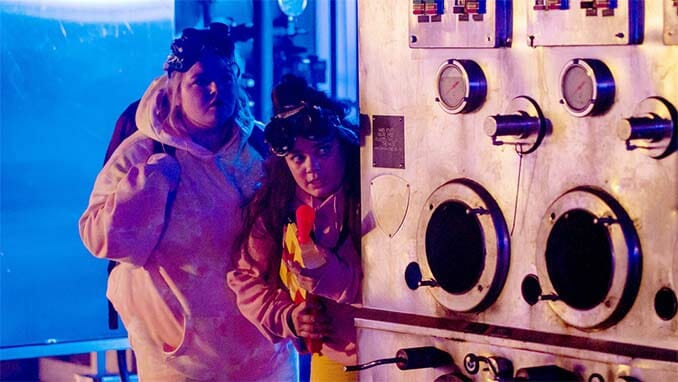Syfy’s Astrid & Lilly Save the World Is a Quirky Throwback with Potential
Photo Courtesy of Syfy
Supernatural teen dramas used to be a dime a dozen. After all, few things are as universally understood as the trials and tribulations of high school. Add in some creepy monsters, some world-saving heroics, and a mysterious figure who seems to have all the answers, and you’ve got the makings of a coming-of-age series jam-packed with relevant and familiar life lessons. But there haven’t been quite as many in recent years, which gives Syfy’s new series Astrid & Lilly Save the World space to breathe.
The show, which hails from co-creators and executive producers Noelle Stehman and Betsy Van Stone, follows the titular outcasts played by Jana Morrison and Samantha Aucoin. They spend their evenings patrolling their hometown and spying on classmates (they’d call it research) to learn how the so-called cool kids spend their time. Their actions—driven by a love for SVU’s Olivia Benson and a desire to fit in—aren’t exactly a secret, and do not endear them to the rest of their class. But they have the effect of literally positioning Astrid and Lilly on the outside looking in, telling us from the start that these two young women aren’t your typical heroines.
In that way, the show follows in the footsteps of another recent Syfy series, the critically beloved and fan-favorite supernatural Western Wynonna Earp. Both shows actively challenge the idea of what a heroine should be and should look like while emphasizing a need for better representation on TV. Wynonna refused to portray its brand of flawed heroine as fragile in the wake of pregnancy and motherhood, while also centering multiple LGBTQIA characters in its narrative. Astid & Lilly centers its story on two plus-sized teens; in doing so, the series becomes a more accurate reflection of the real world while also making a strong statement about who can be a hero.
In the pilot, the two young women attend a party at the home of Tate (Kolton Stewart), a popular classmate who taunts them and calls them the frankly uninspired nickname “Pudge Patrol.” Hurt and angry at being treated like they’re “sub-human,” they seek to exorcise their emotional pain by burning an item that belongs to Tate as a form of catharsis and then dancing their feelings out under the night sky. Unbeknownst to them, however, their actions open a portal to another dimension, one filled with literal monsters instead of just the regular teenage kind. Not long after, they meet a mysterious but knowledgeable (not to mention hunky) stranger named Brutus (Olivier Renaud), who reveals he’s meant to aid them in their mission to close the portal before all of humanity disappears.
It’s a familiar setup: teens being thrust into the world of the supernatural and discovering their inner strength as they come into their own. But what sets the series apart is its keen self-awareness of where it fits into pop culture. The show operates as a supernatural coming-of-age dramedy while simultaneously acknowledging the well-worn tropes and beats of the genre. For example, when Brutus introduces himself to Astrid and Lilly, he refers to himself as their Giles—a reference to Buffy’s (Sarah Michelle Gellar) mentor played by Anthony Head in Buffy the Vampire Slayer, the defining series of this particular genre. Meanwhile, the writers poke fun at what viewers have blindly come to accept over the years, like when Brutus tells them they should have known better than to stand exactly “7.263 feet from each other” and to complete the ritual on “the third Sunday of the ninth month during a pink moon.” The two women also develop powers, but they’re hardly the kind that would benefit them in a fight; Lilly has leg cramps that alert her to the presence of the supernatural, while Astrid gains a heightened sense of smell.
-

-

-

-

-

-

-

-

-

-

-

-

-

-

-

-

-

-

-

-

-

-

-

-

-

-

-

-

-

-

-

-

-

-

-

-

-

-

-

-








































